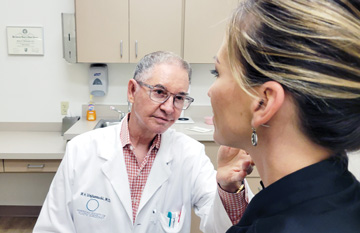The pandemic caused an abrupt shift in the work and social lives of Americans, who found themselves quarantined at home and forced to interact with colleagues and loved ones through calls on Zoom, talks on Teams and discussions on Duo. Many people apparently didn’t like what they saw.
Plastic surgeons are trying to keep pace with an unprecedented demand for cosmetic surgery from patients who are tired of looking at their video images on virtual platforms during countless hours spent logging into remote meetings.
Have I always had those wrinkles? When did my neck skin start sagging? Is my nose really that big? Do my ears stick out that far?
During the pandemic’s quarantine, vacations were postponed, dinners out didn’t happen and cars sat idle instead of guzzling gas. Potential patients were suddenly flush with disposable income and remained at home, where they could recover in relative privacy. Homebound patients also spent more time on social media, seeing before-and-after images of cosmetic surgery and reading testimonials from satisfied patients.
It’s all led to the Zoom Boom, a nationwide spike in demand for cosmetic surgery. The top surgical procedures performed in 2020, according to the American Society of Plastic Surgeons (ASPS), were nose reshapings, eyelid surgery, facelifts, liposuction and breast augmentations. ASPS says demand for injectable treatments was also high throughout 2020. The most requested procedures among the more than 13 million performed were Botox injections, soft tissue fillers, laser skin resurfacing, chemical peels and intense pulsed light therapy.
A national survey of more than 1,000 women conducted by ASPS says 11% of the women who never had cosmetic surgery said they were more interested in the procedures now than before the pandemic, and 24% of the women who had undergone previous cosmetic procedures were more interested in scheduling another treatment. The increased interest in aesthetic procedures shows evidence of continuing, according to the survey, which revealed 35% of women who had undergone previous procedures planned to spend significantly more on cosmetic procedures in 2021 than in 2020. The surgeons interviewed for this story say increasing numbers of men are undergoing cosmetic surgery as well.
There could be another factor behind more patients wanting to look their best. “Zoom dysmorphia” is a term coined by Arianne Shadi Kourosh, MD, MPH, to describe the phenomenon of people developing a negative self-opinion after constantly seeing themselves on virtual platforms. This creates a dangerous cycle of self-criticism based on preoccupations with real or imagined defects that causes them to seek cosmetic corrections they wouldn’t have considered had they not spent months staring at themselves on a video screen.
Looking at self-images displayed on computer screens is like being forced to confront a funhouse mirror.
— Arianne Shadi Kourosh, MD, MPH
Dr. Kourosh, a board-certified dermatologist at Massachusetts General Hospital in Boston, wrote about Zoom dysmorphia in the journal Facial Plastic Surgery & Aesthetic Medicine. She says people see their faces speaking or displaying emotions during virtual calls — perspectives that are not seen during conventional conversations. Additionally, she says, the forward-facing cameras on laptops and phones distort video quality and create an inaccurate representation of true appearance. The closer people sit to the cameras, the more different their faces look. For example, research has shown that cameras positioned 12 inches away from the face instead of five feet increase perceived nose size by 30%. “It’s important for patients to recognize the limitations of webcams and understand that they are, at best, a flawed representation of reality,” says Dr. Kourosh.
Like many aesthetic specialists across the country, Dr. Kourosh saw a larger-than-expected influx of new patients interested in cosmetic procedures. She asked her patients why they sought treatment, and many told her they felt they looked terrible on video conference calls. Her dermatology colleagues had similar experiences with their patients.
Dr. Kourosh, as part of the Women’s Dermatology Society (the organization also includes male providers), helped survey members about the number of cosmetic surgery consultations they had scheduled throughout 2020. Half of the 130 respondents said consults had increased, and 85% of the respondents cited video conferencing as at least one reason patients were interested in having work done. “That’s when we realized the impact video calls were having on the increased demand among our patients was part of a broader trend,” says Dr. Kourosh.
.svg?sfvrsn=be606e78_3)

.svg?sfvrsn=56b2f850_5)